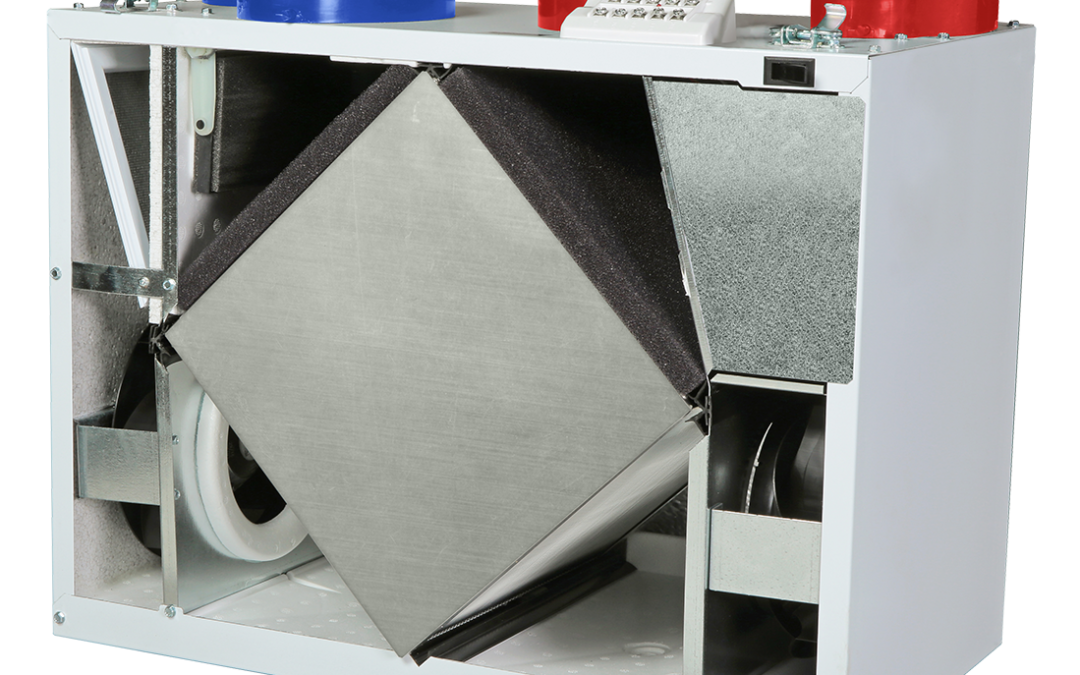What Are HRVs?
HRVs (short for Heat Recovery Ventilators) are a little known but extremely important appliance designed to dramatically improve indoor air quality and energy efficiency. These units are well known in Canada and Europe but are just starting to become popular in the United States. So, what are they and how do they work?
What Are They?
Simply put, HRVs are fresh air ventilation systems that also have a heat exchanger and filters installed. This means that the fresh air brought into a house is both cleaner and much more comfortable than it would be otherwise.

A simple example of how HRV units work. Note that the HRV process also helps remove moisture.
Image source: EP Sales Inc.
How Do They Work?
An HRV works by simultaneously “pushing” fresh outside air into the home and “pulling” stale indoor air out of the home. This is known as “balanced ventilation” and is widely considered the most effective way to ventilate a building.
In the most common design, these air flows never actually directly contact each other (which could create cross contamination) but instead run through different channels in a metal or plastic heat exchanger which is usually shaped like a cube.
This process allows 70-95% of the heat from the indoor environment to be recovered, dramatically improving comfort and HVAC efficiency (which no longer has to heat or cool all of the air coming into the house).
Additionally, the filters on the HRV help remove particulates and improve the quality of the incoming air. Filter quality varies significantly and includes everything from simple foam filters to extremely high quality HEPA grade filters. Usually the only maintenance required is replacing or cleaning the filters.

This image shows how a whole house HRV system can work.
Image source: Temprite Climate Solutions
What About Indoor Air Quality?
This will be covered in greater detail in a future post, but the short version is that indoor air quality has an enormous impact on health and well being. Studies have linked good indoor air quality to many benefits, including: improved cognitive function, greater health and energy, higher test scores, and better sleep.
Modern humans spend roughly 87% of our time inside a building, so the quality of indoor air can have tremendous positive or negative effects on our minds and bodies. Sufficient ventilation is critical to avoid or reduce dangers such as radon, mold, carbon monoxide, and chemical off gassing.
What Options Are Available?
HRVs come in a wide variety of features and options. To make sure you are getting the appropriate unit, here are some considerations:
-
Heat exchange efficiency – This usually ranges from 70-95%, higher is better!
-
Quality of filters – Everything from simple foam pads to HEPA grade filters are available.
-
Maximum air flow – HRVs should be sized to the area they are ventilating. The average house only needs one central unit that is sized right.
-
Controls – Different units have different control features. Some will run at maximum power when high humidity is detected, or will run at selected time intervals.
-
Dedicated or existing ducts – HRVs can be installed as a dedicated system or can be connected to an existing duct system to reduce costs. Units in a dedicated system are more effective and efficient.
Efficiency First Solutions is Central California’s premier provider of Aerobarrier air sealing and HRV installations for residential and commercial applications.
Give us a call and learn how we can increase energy efficiency, improve comfort, boost indoor air quality, and reduce sound transmission in your buildings!
Office: (805) 380 2483
Email: info@efficiencyfirstsolutions.com
Our services are available in:
- San Luis Obispo County
- Monterey County
- Santa Barbara County
- Ventura County
- Santa Cruz County
- Fresno County
- Madera County
- Kern County
- Kings County
- Tulare County
- San Benito County


